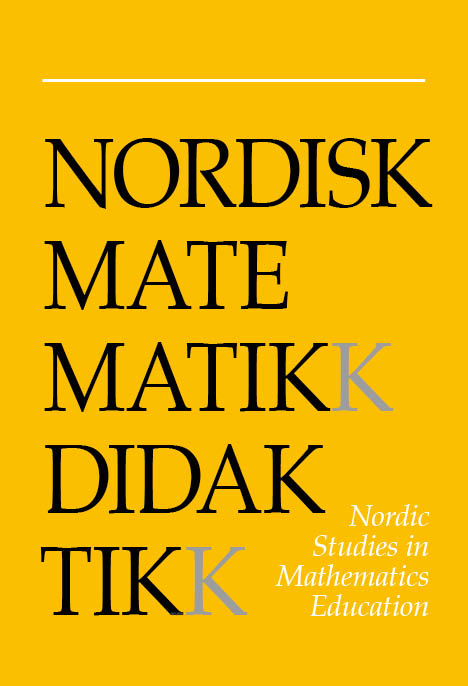Modellerings betydning for tilegnelsen af matematiske begreber
DOI:
https://doi.org/10.7146/nomad.v1i1.144987Abstract
For at illustrere betydningen af virksomhed med matematisk modellering for elever nes tilegnelse af matematiske begreber i den elementære matematikundervisning giver artiklen dels en teoretisk diskussion, dels en præsentation af nogle af over vejelserne bag og resultaterne af et udviklingsarbejde vedrørende modellering af dynamiske systemer ved hjælp af differensligninger og regneark. Udviklingsarbejdet har omfattet undervisningsforløb i matematikundervisningen på 9. og 10. klassetrin i den danske folkeskole. Under forløbene har eleverne arbejdet med at opbygge, analysere og kritisere matematiske modeller. Analysen har vist, at elevernes virk somhed med modellering indeholder et væsentligt potentiale i forhold til elevernes tilegnelse af de matematiske begreber, der indgår i virksomheden. Artiklen bygger på et udviklingsarbejde, der er en del af en Ph.D.afhandling med titlen ”Samspil mellem teori og praksis i matematikkens didaktik”.
References
Blomhøj, M. (1992a). Modellering i den elementære matematikundervisning – et didaktisk problemfelt (Tekst MI 58). København: Matematisk Institut, Danmarks Lærerhøjskole.
Blomhøj, M. (1992b). Samspil mellem teori og praksis – en forskningspraksis i matematikkens didaktik (Tekst MI 59). København: Matematisk Institut, Danmarks Lærerhøjskole.
Blomhøj, M.,&Bredo,O.(1992).Problemløsningbørogsåværerefleksion.Psykologisk Pædagogisk Rådgivning, 29(6), 470-487.
Blum, W. (1991). Applications and modelling in mathematics teaching – A review of argu ments and instructional aspects. In M. Niss, W. Blum, & I. Huntley (Eds.), Teaching of mathematical modelling and applications (pp. 1030). Chichester: Ellis Horwood.
Blum, W., Niss, M., & Huntley, I. (Eds.) (1989). Applications, modelling and applied problem solving. Chichester: Ellis Horwood.
Blum, W., & Niss, M. (1989). Mathematical problem solving, modelling, applications, and links to other subjects – State, trends, and issues in mathematics instruction. Educational Studies in Mathematics, 22, 3768. https://doi.org/10.1007/BF00302716
Cobb, P. (1989). Experiential, cognitive, and anthropological perspectives in mathematics education. For the Learning of Mathematics, 9(2), 3241.
Cobb, P. (1988). The tension between theories of learning and instruction in mathematics education. Educational Psychologist, 23(2), 87103. https://doi.org/10.1207/s15326985ep2302_2
Gurtner, JL., León, C., Nunez, R., & Vitale, B. (1993). The representation, the understanding, and the mastering of experience: Modelling and programming in a school context. In J. de Lange, I. Huntley, C. Keitel, & M. Niss (Eds.), Innovation in mathematics education by modelling and applications (pp. 6369). Chichester: Ellis Horwood.
Kulturministeriet. (1990). Matematik. Undervisningsvejledning for almen voksen uddannelse. København: Kulturministeriet.
Larsen, I. B., Malmberg, A. C., & Sadolin, V. (1992). Edb-modeller i matematikundervisningen (MItekst 51). København: Matematisk Institut, Danmarks Lærerhøjskole. Lerman, S. (1989). Constructivism, mathematics, and mathematics education. Educational Studies in Mathematics, 20, 211223.
Malmberg, A. C. (1987). Datamodeller – på tværs af fagene. København: Gjellerup & Gad.
Niss, M. (1989). Aims and scope of applications and modelling in mathematics curricula. I: Applications and modelling in learning and teaching mathematics. In W. Blum, M. Niss, & I. Huntley (Eds.), Applications, modelling, and links to other subjects. Chichester: Ellis Horwood.
Author. Modellerings betydning for tilegnelsen af matematiske begreber
Niss, M. (1987). Applications and modelling in mathematics curriculum – State and trends. International Journal of Mathematical Education in Science and Technology, 18 (4), 487505. https://doi.org/10.1080/0020739870180401
Niss, M. (1980). Nogle perspektiver for matematikundervisningen i de gymnasiale uddan nelser frem til 1990. Normat, 28(2), 5460.
Sadolin, V. (1991). infaREGN – en brugervejledning (Tekst MI 26). København: Matematisk Institut, Danmarks Lærerhøjskole.
Sadolin, V., & Blomhøj, M. (1992). Dynamiske modeller i infaREGN (Tekst MI 72). København: Matematisk Institut, Danmarks Lærerhøjskole.
Steinbring, H. (1989). Routine and meaning in the mathematics classroom. For the Learning of Mathematics, 9(1), 2433.
Undervisningsministeriet. (1988). Matematik. Bekendtgørelse og vejledende retningslinier (Hæfte nr. 19 i serien om reglerne for fagene i gymnasiet). København: Undervisnings ministeriet.
Undervisningsministeriet. (1990). Edb i folkeskolens fag. Regning/matematik og edb. Und- er-visningsvejledning for folkeskolen. København: Undervisningsministeriet.
Vitale, B. (1991). Processes: A dynamical integration of informatics into mathematical education. In C. Hoyles, & R. Noss (Eds.), Logo and mathematics; Research and cur- riculum issues. Cambridge: MIT Press. https://doi.org/10.7551/mitpress/4171.003.0021
Wyndhamn, J. (1992). Matte i livet – livet i matte – Några funderingar om det situations bundna tänkandet. I G. Emanuelsson, B. Johansson, B. Rosén, & R. Ryding (Red.) Dokumentation av 7:e Matematikbiennalen (avsnitt M10). Göteborg: Matematikavdelningen Institutionen för ämnesdidaktik, Göteborgs Universitet.
Downloads
Published
How to Cite
Issue
Section
License

This work is licensed under a Creative Commons Attribution-NonCommercial-ShareAlike 4.0 International License.



